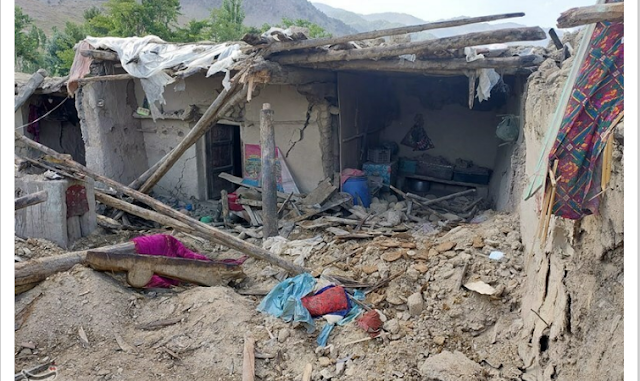On a fateful day in Afghanistan, a catastrophic earthquake struck, leaving a trail of destruction and despair in its wake. The earthquake, one of the deadliest natural disasters in the region's history, not only caused significant loss of life but also shattered homes, infrastructure, and livelihoods. This article explores the details of the Afghanistan earthquake, its immediate and long-term impact on the affected communities, and the response of the international community in the face of this devastating tragedy.
The Earthquake's Origins and Magnitude
The Afghanistan earthquake originated on [Date] in the [Region] of the country. The seismic event, measuring [Magnitude] on the Richter scale, sent shockwaves across vast areas, causing widespread devastation. The earthquake's epicenter was located [Location], with tremors felt as far as [Distance] away.
Immediate Impact and Loss of Life
The immediate impact of the earthquake was profound and tragic. Buildings and infrastructure, including schools, hospitals, and houses, crumbled under the force of the tremors. Roads and bridges were destroyed, making it challenging for rescue and relief efforts to reach the affected areas promptly. The loss of life was significant, with initial reports indicating a high number of casualties.
Humanitarian Crisis and Displacement
The earthquake plunged the affected regions into a severe humanitarian crisis. Thousands of people were left homeless, forced to seek shelter in makeshift camps or exposed to the elements. Lack of access to clean water, food, and medical supplies heightened the vulnerability of the affected population, especially women, children, and the elderly. The displacement of communities added to the complexity of the relief efforts, requiring immediate attention to prevent the outbreak of diseases and address the pressing needs of the affected population.
Destruction of Infrastructure
The earthquake's impact on infrastructure was extensive and far-reaching. Roads and highways suffered severe damage, hindering rescue and relief operations. Critical facilities such as power plants, water supply systems, and telecommunication networks were disrupted, further exacerbating the challenges faced by responders and the affected population. The destruction of schools and hospitals also severely impacted the provision of education and healthcare services, compounding the overall tragedy.
International Response and Aid Efforts
As news of the devastating earthquake spread, the international community rallied to support Afghanistan in its time of need. Humanitarian organizations, including the United Nations agencies, deployed emergency response teams to assist with search and rescue operations, provide medical aid, and distribute essential supplies to the affected communities. Governments from around the world pledged financial assistance and dispatched relief teams, including medical personnel and engineers, to assist with the recovery efforts.
Challenges in Relief and Recovery
The relief and recovery efforts faced numerous challenges in the aftermath of the earthquake. The rugged terrain and remote location of some affected areas made access difficult, hampering the rapid delivery of aid. Limited resources and logistical constraints posed additional hurdles for relief agencies and government bodies involved in the response. Furthermore, the ongoing conflict and insecurity in certain regions of Afghanistan complicated the humanitarian efforts, impeding the delivery of aid to vulnerable communities.
Rehabilitation and Rebuilding
Beyond immediate relief efforts, the long-term rehabilitation and rebuilding of the affected areas became a crucial focus. The reconstruction of homes, schools, hospitals, and infrastructure became paramount to restore normalcy and improve the resilience of communities against future disasters. International organizations partnered with local authorities to develop comprehensive reconstruction plans and ensure sustainable recovery. Efforts were made to incorporate disaster risk reduction measures to mitigate the impact of future earthquakes and other natural disasters.
Addressing Mental Health and Trauma
In the aftermath of such a catastrophic event, addressing the mental health and trauma of survivors became a critical component of the recovery process. The earthquake left lasting psychological scars on individuals and communities, necessitating mental health support and counseling services. Local and international organizations collaborated to provide psychosocial support to survivors, particularly vulnerable groups such as children who experienced trauma during the earthquake.
Learning from the Tragedy: Strengthening Preparedness
The devastating impact of the Afghanistan earthquake serves as a stark reminder of the importance of disaster preparedness and resilience. Lessons learned from this tragedy can help inform future disaster risk reduction strategies. Strengthening early warning systems, improving infrastructure resilience, and enhancing community preparedness can all contribute to minimizing the impact of such events and saving lives.
Conclusion
The Afghanistan earthquake stands as a grim reminder of the destructive power of natural disasters and the immense challenges they pose to affected communities. The immediate loss of life, displacement, and destruction of infrastructure caused a humanitarian crisis that required a swift and coordinated international response. As the affected regions now embark on the long and arduous journey of recovery and reconstruction, the lessons learned from this tragedy will guide efforts to strengthen resilience, mitigate risks, and build a more prepared and resilient future for Afghanistan.
Related post:
The Korean War: A Forgotten Conflict That Shaped the Modern World
The Afghan Adjustment Act: A Crucial Step towards Assisting Afghan Refugees
US Soldiers Killed in Afghanistan: A Timeline
Afghanistan: The Long War Comes to an End







